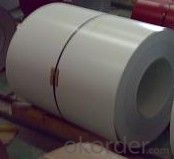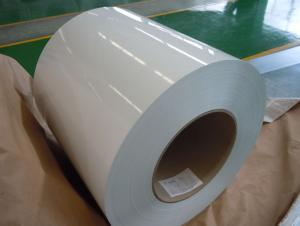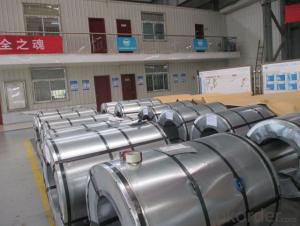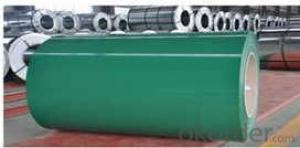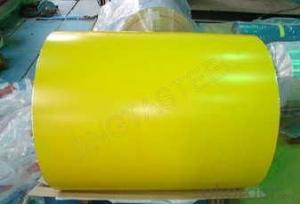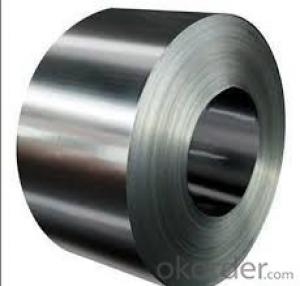EXCELLENT COLOR COATED STEEL COIL-RAL 9003
- Loading Port:
- China Main Port
- Payment Terms:
- TT OR LC
- Min Order Qty:
- -
- Supply Capability:
- -
OKorder Service Pledge
OKorder Financial Service
You Might Also Like
EXCELLENT COLOR COATED STEEL COIL-RAL 9003 2) Standard: JIS G3302, JIS G3312, ASTM A653M/A924M 1998 | |||||
3) Grade: Q195-Q235 and SPCC, SPCD, SPCE, SGCC (DX51D+Z) SGCD (DX52D+Z), etc. | |||||
4) Thickness: 0.25mm-1.5mm | |||||
5) Zinc coating weight: 60g/m2-275g/m2 | |||||
6) Width: 750mm-1250mm, or according to the customer's request | |||||
7) Coil ID: 508mm-610mm | |||||
8) Coil Weight: according to the customer's request | |||||
9) Color: RAL, or other series | |||||
10) Surface protection: PE, PVDF, SMP, HDP, etc. | |||||
11) Surface treatment: chromate, oil/unoil, bright finish, spangle, anti-finger print | |||||
12) Min trial order: 20 tons each size, 1x20' per delivery | |||||
| | | | | | |
| | | | | | |
| | | | | | |
|
|
|
|
|
|
Applications : | |||||
1. Contruction and building: roofing; ventilating duct; handrail; partition panel;etc. | |||||
2. Electric appliance: refrigerator; washing machine; refrigerator; DVD;etc. | |||||
3.Transportation: oil tank; road sign; etc. | |||||
4.Agriculture:barn; etc. | |||||
5.Others:vending machine; game machine; etc. | |||||
Advantages:
1. Low MOQ: It can meet your promotional business very well.
2. Good Service: We treat customers as our friends
3. Good Quality: We have strict quality control system; don’t sell the poor quality goods
4. Best price: Choosing superior resources from more than five factories for you
5. Fast & Cheap Delivery: We have big discount from forwarder
- Q: I mean, besides the light weight and other graces of Aluminium and Carbon, Steel frames are absolutely out-dated and they have nothing to do these days... or it is still possible to enjoy a nice ride on our heavy old pals?
- Au contraire; many great bikes are still steelies. Today's steel is much lighter than 10 yrs ago.
- Q: I want to anodize steel using heat. some steel turns gray instead of coloring when I heat it up using a torch.
- Steel doesn't anodize in the sense that aluminum and some other metals do. However, it can be heat-colored. The trick is to clean the surface first (it must be oxide free), then heat gently until the colors appear. These are called temper colors in steel. They are due to a thin adherent layer of oxide that forms and thickens as temperature is increased. They are quite temperature dependent. As the steel is heated, the first color to appear is pale yellow. This will progress through darker yellows, browns, purples, and blues as the temperature rises. Above blue, the oxide becomes the gray/black color you are apparently getting - this is the result of heating too fast and too hot. See the chart at the site below for colors in plain carbon steel. Note that the temperatures are pretty low - It all starts around 400 F and if you go above 600 F the show's all over.
- Q: How are steel coils used in the manufacturing of construction cranes?
- Steel coils are used in the manufacturing of construction cranes to provide structural strength and durability. These coils are typically shaped and welded to form the main framework of the crane, which supports heavy loads and ensures stability during operation. Additionally, the steel coils are used to fabricate various components such as the boom, jib, and counterweights, which contribute to the crane's lifting capacity and overall functionality.
- Q: What are the different methods of engraving steel coils?
- There are several methods of engraving steel coils, including laser engraving, chemical etching, mechanical engraving, and electrochemical etching. Each method involves different techniques and tools to create precise and permanent markings on the surface of the steel coils.
- Q: How are steel coils shipped internationally?
- To ensure the safe and efficient transportation of steel coils internationally, various methods are utilized. The most commonly employed technique involves container shipping, where steel coils are placed in standard shipping containers. These containers are specifically designed to handle heavy and bulky cargo like steel coils. To load the steel coils into the containers, they are typically stacked horizontally and secured with steel strapping or metal bands to prevent any movement during transit. This ensures stability and minimizes the risk of damage. Additionally, wooden or metal dunnage may be used to separate and secure the coils, further preventing any shifting. Once loaded, the containers are sealed and transported to the port using trucks or trains. At the port, the containers are loaded onto cargo ships utilizing crane or specialized equipment, such as roll-on/roll-off (RO-RO) vessels or semi-submersible ships. These ships provide a protected environment for the steel coils during the journey, shielding them from adverse weather conditions and potential damage. Throughout the voyage, the steel coils are subjected to various safety measures to prevent corrosion and maintain their integrity. These measures include the application of protective coatings, such as oil or special paints, as well as the use of desiccants or humidity control systems inside the containers to regulate moisture levels and minimize the risk of rusting. Upon arrival at the destination port, the containers are unloaded from the ship and transferred to trucks or trains for further transportation to their final destination. At this stage, the steel coils may undergo customs clearance and inspection procedures before being delivered to the intended recipients. In conclusion, the international shipping of steel coils requires careful planning, secure packaging, and the utilization of specialized containers and equipment to ensure their safe and successful transport.
- Q: How are steel coils inspected for edge quality using visual inspection?
- To ensure that steel coils meet the necessary standards and specifications, visual inspection methods are employed to assess their edge quality. This involves carefully examining the edges of the coils to identify any defects or imperfections that may have occurred during manufacturing or handling. During this inspection process, trained inspectors visually assess the edges of the steel coils for various parameters, such as burrs, cracks, unevenness, roughness, and other irregularities that could impact the steel's quality and performance. To conduct these assessments, they utilize specialized tools like magnifying glasses, microscopes, or cameras to closely observe and analyze the edges. Each coil is meticulously inspected by the inspectors to detect any signs of defects that could potentially affect the steel's functionality or integrity. They pay meticulous attention to detail, ensuring that the edges are smooth, devoid of sharp edges or protrusions, and possess consistent dimensions throughout the coil. Apart from visual inspection, inspectors may also employ specific testing methods like dye penetrant testing or ultrasonic testing to further evaluate the quality of the steel coil edges. These supplementary tests aid in detecting any hidden defects that may not be visible to the naked eye. As a whole, visual inspection plays a vital role in the quality control process for steel coils by allowing for the identification and elimination of edge defects that could compromise the steel's performance and durability. By ensuring that the edges meet the required standards, visual inspection helps to uphold the quality and dependability of the steel coils.
- Q: How are steel coils used in the production of pressure vessels?
- Steel coils are used in the production of pressure vessels as they provide a strong and durable material for constructing the vessel's shell. The coils are formed into cylindrical shapes and welded together to create the vessel's body. This ensures that the vessel can withstand the high pressures it is designed to hold, making steel coils an essential component in pressure vessel manufacturing.
- Q: I have a white gold engagement ring, and to be special I thought I'd get a plain band from Tiffany's--in stainless steel. Can stainless steel be worn with white gold or will there be a difference in the color or texture? I'm not planning on getting them soldered together, but I don't want it to be noticeable that they are different metals. Does anyone have experience in this subject?
- Stainless Steel Matching Wedding Bands
- Q: How are steel coils inspected for straightness?
- Steel coils are typically inspected for straightness using various methods such as visual inspection, laser measurement, or by passing the coils through straightening equipment.
- Q: How are steel coils used in the appliance industry?
- Steel coils are used in the appliance industry to manufacture various components such as outer panels, frames, and internal structures of appliances like refrigerators, washing machines, and ovens. The coils are processed to create specific shapes and sizes, providing strength, durability, and stability to the appliances.
Send your message to us
EXCELLENT COLOR COATED STEEL COIL-RAL 9003
- Loading Port:
- China Main Port
- Payment Terms:
- TT OR LC
- Min Order Qty:
- -
- Supply Capability:
- -
OKorder Service Pledge
OKorder Financial Service
Similar products
Hot products
Hot Searches
Related keywords





